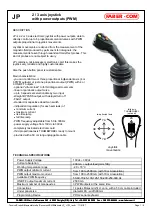
MX31 Cab, MX31FU Radio Cab Page 11
The
RG
key
accesses shunting functions and, if not assigned differently,
splits the speed range
of the speed slider in half that is, with the speed
regulator at full throttle the loco travels only at half throttle. The
RG
key is de-
fined in the LOCO menu and is most often used for shunting speed functions
of decoders (often with F3, F4 or other key) but also to reduce/suspend mo-
mentum as per CV #3, 4 etc.
The
MAN function,
MN
key,
eliminates the ZIMO “signal controlled speed
influence” or other methods of “location dependent control” (asymmetrical
DCC, Lenz “ABC”). The accompanying LED blinks when the MN function is active that is, the
speed limits are cancelled. The MAN function is used to drive past red signals during shunting,
train movements without routes in secured areas that otherwise wouldn’t be possible etc. The
MAN function normally sends a special ”override speed restriction” command to the decoder but
other modes of action can also be assigned to the MN key in the LOCO menu.
NOTE: The
MN
key only works with decoders equipped with that function, at this time (2006) only
with ZIMO decoders!
The
function outputs
of a decoder (headlights etc) are
switched with the number keys that operate as
function keys
F0, F1, F2, …
For
F10, F11, F12, …
(with future software
versions
up to F19
)
press and hold the shift key first.
The LED’s above the number keys indicate the state of the
outputs (no LED for F9). Each function key can be changed
from its default “always on” setting (= press function key turns
function on, press again to turns off) to a momentary setting (=
function is on only as long as the function key is pressed), with
the help of the E-procedure “MD” or via the LOCO menu.
With the
T key,
an active locomotive can be added to a
consist,
indicated in
the display with a “T” to the right of the address. All locos stored in the recall
memory of the cab that are marked with a “T” belong to the same consist and
are controlled simultaneously with the speed slider, direction key R, stop key
S,
shunting key
RG
and MAN key
MN,
regardless of which address is currently
displayed as active in the display or which loco is the lead loco.
Use the F key to scroll through the individual consist addresses (all addresses marked with a
“T”) or use the tabular display of the recall memory by double-clicking the A key.
Remove a locomotive from a consist by pressing the T key again with the relevant loco address
displayed as being active.
♦
The actual meaning of the
soft keys
for most situations is indicated
in the display (e.g. EXPERT, GUEST or switching of assigned turn-
outs), with the exception of the soft key “M”, which usually serves to
open the context sensitive menus. For example, pressing the “M” key in the LOCO mode opens
the LOCO menu at first and from there branches off to the SYSTEM or CAB menu, if desired.
WHERE TO AND BACK? (current loco remains active and returns cab to the LOCO mode again)
►
Start an
E-Procedure
with
key sequence E-x
(E, followed by the key for the appropriate E-
procedure), use the “A” key to accept the changes made and exit E-procedures or use the “E” key
to exit without any changes taking place,
►
E- MN
(press and hold “E” followed by “MN”) starts
programming
(see chapter “Programming”) in
service mode (
SERV MODE PROG
on the
programming track
), exit programming with the “E”
key,
►
E- F
or
E-W
(press “E” together with the “F” or “W” key) starts
programming
(see chapter “Pro-
gramming”) on the main
(OP. M. PROG)
, exit with “E” key.
►
The
soft key M
opens the MENU (see chapter “MENU and MENU functions”); return with the E
key if no other state is entered with the selected menu item (may need to be actuated several
times).
WHERE TO? (current loco address will usually be deactivated)
►
Deactivating current address with the
“A” key
(or
-A)
-> changes cab to
Address Input
mode
(yellow),
NOTE: use of A key is only possible in OPERATOR mode – in EXPERT mode use
-
A
, or
►
Deactivate current address and activate next address from the LOCO
recall memory
with the
“F” key
(which is the loco that was deactivated last) or
►
Deactivate and
delete
current address
(from recall memory) with the
“C” key.
Also activates the next
address automatically from the recall memory (same as with “F” key), or
►
Deactivate current address with the
“W” key
-> switches to the
SWI mode
(red), whereby
the last active accessory address (or switch ladder) will be activated, or
►
Open the recall memory table
(LOCO RECALL MEM)
by pressing the
“A” key twice
(press key
twice within half a second) -> Tabular display of the recall memory (green), “A” key activates selec-
tion and “E” key exits; see chapter “recall memory”, or
►
Open the
LIST of NAMES
with simultaneous
E-4
(press “E” ahead of “4” key) or
A+A+4
(in se-
quence) -> Tabular display of names (yellow) for engine and turnout addresses, “A” key activates
selection and “E” key exits; see chapter “recall memory and list of names”.
….
A key
From the LOCO mode with
… …
to the address input page
….
F key (rotate through memory)
….A + A key (tabular display)
to other engines in recall memory … …direct …via tabular display












































